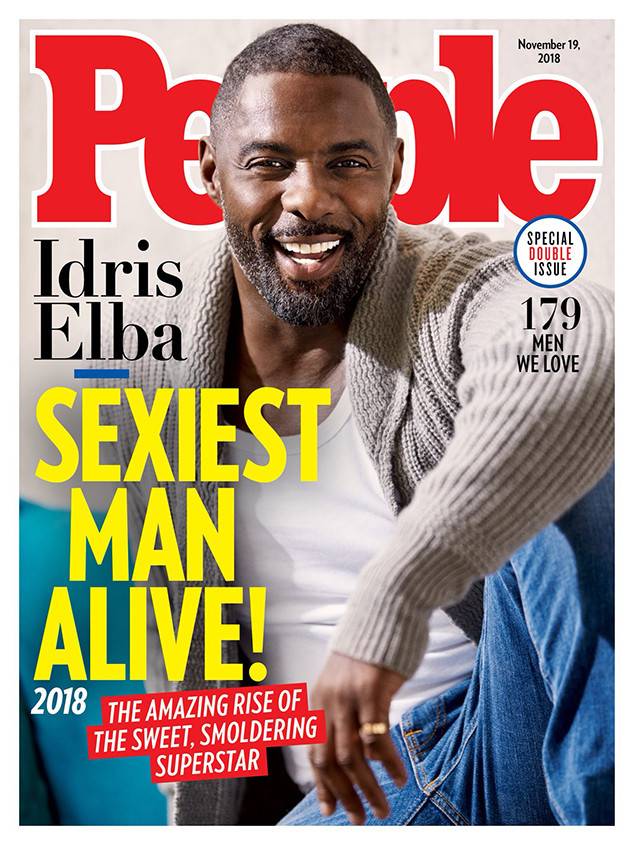by Ashley Anderson and Kimberly Joseph
In 2018, Idris Elba was (understandably) named People Magazine’s Sexiest Man Alive. He is the third person of color to be selected for this title, with Denzel Washington snagging the title in 1996 and Dwayne “The Rock” Johnson getting it twenty years later in 2016. Technically, four men of color have been given this title, but People did not select anyone during 1994, as the Sexiest Man Alive cover was published during slow news periods and the magazine had more interesting things to publish. They later announced Keanu Reeves, a man of Chinese-Hawaiian descent, as its recipient for 1994 in 2015 in honor of the award’s 30th anniversary. This annual selection has showcased famous celebs chosen by People staff members since the tradition began with Mel Gibson in 1985. In this time, white men such as George Clooney, Brad Pitt, and Johnny Depp have been named Sexiest Man Alive not only once, but twice. If this award is supposed to be the benchmark for male attractiveness, what is People Magazine telling the world when only 10% of the honorees are men of color while they double down on white dudes?
How men are chosen for the honor is somewhat of a mystery. In 2010 People Managing Editor Larry Hackett tried to give more context: “We know it has to be a mix of someone who’s hot but well-known. Not too young, not too old and somebody who, frankly, maybe we haven’t thought of…..We want some mystery in our sexiness.” People also publishes its 100 Most Beautiful People list annually, a list of one hundred people judged to be the most beautiful individuals in the world. In thirty years of these lists people of color have appeared in the number one spot only twice (Beyonce Knowles in 2012 and Lupita Nyong’o in 2014). People has listed a Sexiest Woman Alive only once—blonde haired, blue eyed Kate Upton—in 2014.
Is this representative of an ongoing lack of diversity in the entertainment industry, or the insidious and ever-present notion that white is the standard of beauty in Western society? Maybe. But more importantly, what do we do about it?
While it may not seem to be anything more than another diversity problem, the lack of people of color named as Sexiest Man Alive or the #1 most beautiful person sends readers of People Magazine a clear message: People of color don’t meet our standards of beauty. Perhaps the fact that they have previously named Beyoncé and Lupita Nyong’o, two prominent, clearly black celebrities, as the most beautiful women makes it seem like People Magazine is recognizing beauty in people of color. But there is more here than meets the eye, so to speak. When we examine the celebrities they chose, some very important elements come to light. Beyoncé is a light skinned black woman, with a lot of European features, and long, straight hair. Her features do not negate her blackness, but they do match the Western beauty standards all too well. While we can celebrate Lupita as a dark skinned woman with traditionally African and/or Black features, she may count as the only person of color chosen despite not meeting European standards of beauty. Knowing how long this list has been published, this statistic is nothing to celebrate.
Elle attempted to “highlight a more inclusive standard of what’s considered beautiful—for women and men alike,” when they published a piece in 2015 called “30 of the Sexiest Men Alive Who Aren’t White.” At the time that they published the piece, 29 out of the 30 Sexiest Man Alive recipients had been white. Interestingly enough, the year after this is when Dwayne ¨The Rock¨ Johnson was awarded the title. Could this decision have been influenced by the Elle article? Even if it was, it was not the most successful ploy on People’s part: it received a lot of backlash for being a way to both pacify people of color and to profit from their struggles.
So what is the best way to address and include people of color in the beauty industry? It is representation. One only has to look at something as recent as the comic of Serena Williams after the French Open to see how physical traits of people of color have been derided in Western societies. Historically speaking, the features of people of color have been exaggerated in order to mock and degrade them.
Mercifully, things are changing. There are signs of increasing representation in popular media. For example, model Chrissy Teigen is a Thai woman who is consistently considered a symbol of beauty, having been a Sports Illustrated cover model multiple times. Many other Thai people love that she is considered beautiful because she has traditionally Thai features and is celebrated for them.
Showing the world that influencers of color, whether they are athletes, scholars, actors, musicians, or in another profession, are considered just as beautiful and capable as their white counterparts is a great way to inspire and instill confidence in people of color.
Kim Joseph and Ashley Anderson are students in English 291: What Is Racial Difference?

